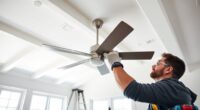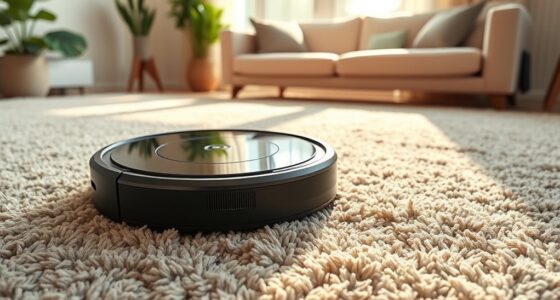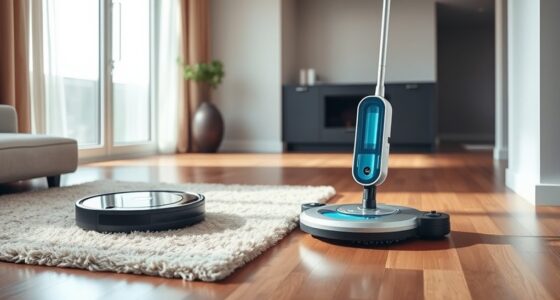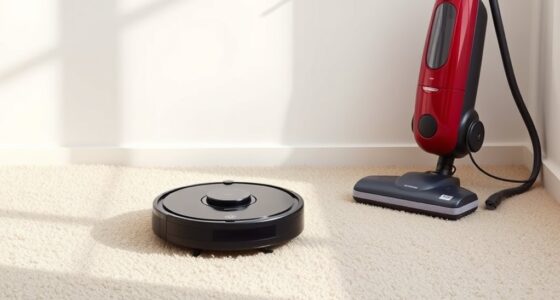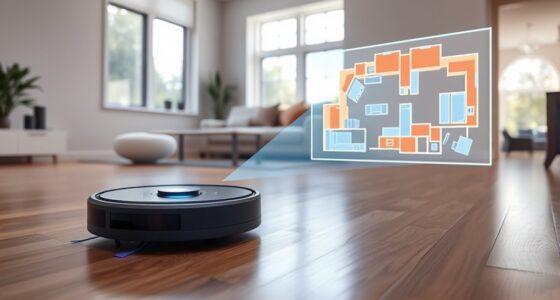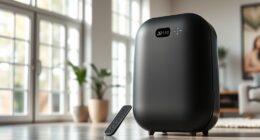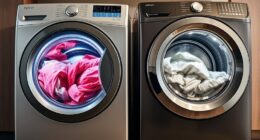To reduce noise from your robot vacuum, start by choosing models with noise reduction features or lower decibel ratings. Regularly clean brushes and filters to keep noise levels down and guarantee smooth operation. Operating during less busy times, like when household activity is minimal, also helps. You can also create a quieter environment by sealing doors, adding soft furnishings, or using soundproofing materials. Want more tips? Keep exploring for additional ways to make your vacuum operation quieter.
Key Takeaways
- Use noise-canceling headphones or earplugs to block vacuum sound during operation.
- Choose robot vacuums with lower decibel ratings and noise reduction features.
- Schedule cleaning during times when household activity is minimal or occupants are out.
- Regularly clean and maintain brushes, filters, and wheels to prevent excess noise.
- Add soft furnishings, rugs, or soundproofing materials to absorb and dampen noise in the environment.
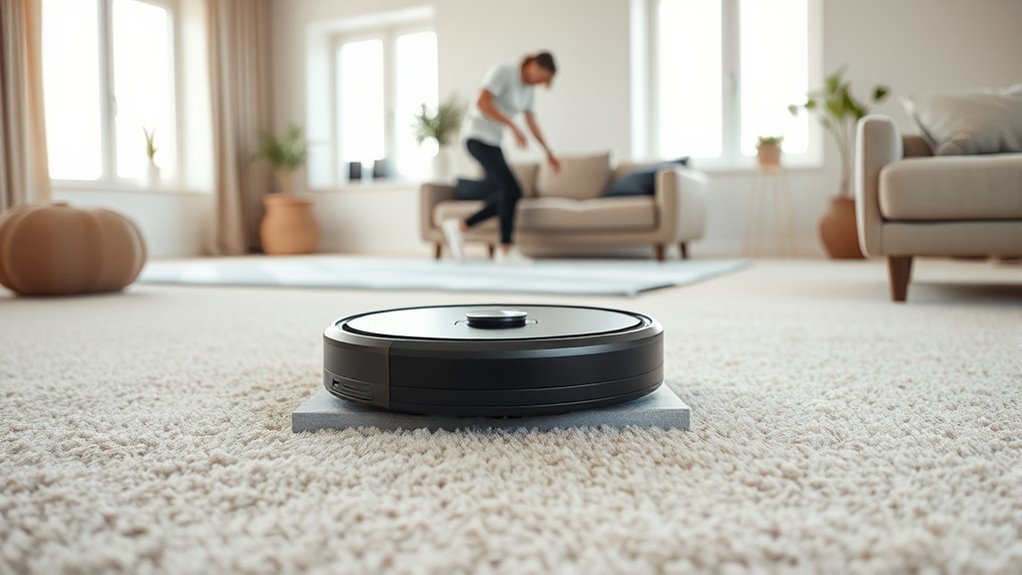
You are trained on data up to October 2023. To further minimize noise, consider using noise-canceling headphones when operating the vacuum to block out the sound.
Frequently Asked Questions
Can Changing the Vacuum’S Location Decrease Noise Levels?
Yes, changing your robot vacuum’s placement can decrease noise levels. A good placement strategy involves placing the vacuum on a soft surface or away from quiet areas to minimize sound transmission. You can also use acoustic barriers, like furniture or rugs, to absorb noise. By positioning the vacuum thoughtfully, you reduce the sound that travels through walls and floors, making your space more peaceful during cleaning.
Does Replacing the Motor Reduce Overall Noise?
Replacing the motor can considerably impact noise reduction in your robot vacuum. When you opt for a quieter, more efficient motor, it runs smoother and quieter during operation. This upgrade minimizes vibrations and motor noise, making your vacuum less disruptive. You’ll notice a difference in overall noise levels, especially if your current motor is worn or noisy. So, motor replacement is a smart step toward quieter cleaning and improved performance.
Are There Specific Brands Known for Quieter Robot Vacuums?
Did you know some robot vacuums operate at only 55 decibels, quieter than a whisper? When shopping for quiet brand options, focus on noise level ratings listed in product specs. Brands like iRobot’s Roomba i7 and Eufy’s RoboVac series are known for their quieter operation. You’ll find these options help keep your space peaceful, especially if you’re sensitive to noise or have a sleeping household.
How Does the Type of Flooring Affect Noise Production?
Flooring impact considerably influences your robot vacuum’s surface noise. Hard floors like tile or hardwood tend to produce more surface noise because the vacuum’s brushes and wheels create louder sounds on smooth surfaces. Carpets absorb some of this noise, making it quieter. If you’re looking to reduce noise, consider the type of flooring in your space, as it directly affects how loud your vacuum operates during cleaning.
Can Software Updates Help in Noise Reduction?
While it’s a gentle nudge to think about how your robot vacuum operates, software optimization and firmware improvements can indeed help in noise reduction. These updates refine motor control and sensor responsiveness, making the device run more smoothly and quietly. By regularly updating your vacuum’s software, you guarantee it functions at its quietest, enhancing your comfort without sacrificing cleaning power. Embrace these upgrades for a more peaceful, efficient cleaning experience.
Conclusion
Now that you know how to cut down the noise from your robot vacuum, you can enjoy a quieter home without sacrificing clean floors. Remember, sometimes a little tweak here and there can make all the difference. Don’t be afraid to experiment with your settings or add soundproofing measures. After all, a silent house is worth more than gold, and with these tips, you’ll keep things peaceful and tidy without breaking a sweat.

